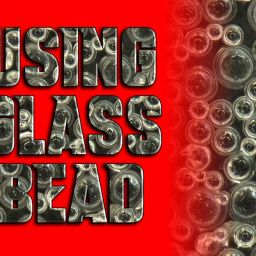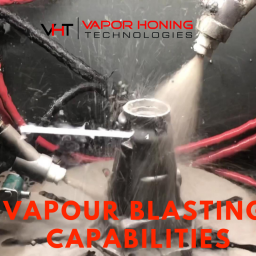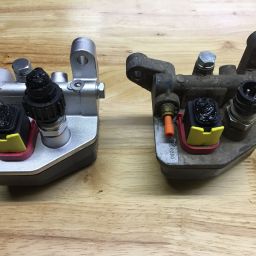Vapor Blasting vs Sand Blasting: Which Is Best for My Needs?
Whether you’re painting, resurfacing automotive parts, or smoothing cnc machined parts the first step is to prepare the surface. Surface preparation plays an integral role in how well a coating adheres to the surface. Also, surface preparation is also key in creating aesthetically pleasing parts for your customer.
The big question people often ask is if vapor blasting vs sand blasting is better for their project. That answer depends on several factors.
What is your end goal? Are you trying to create an appealing surface on a part without damage to the part itself?
The two most popular options are vapor blasting and sand blasting. Both work well but will certainly give different results. But how do you choose?
Here’s everything you need to know about vapor blasting vs sand blasting to pick the right one to fit your needs!
What to Know About Vapor Blasting
Vapor blasting is a method of removing debris and contaminants from a surface using pressurized water mixed with abrasive media. If you add the media to the water before blasting, the process is often known as slurry blasting. You may hear vapor blasting referred to as wet blasting, vapor honing, liquid honing, or dustless blasting.
Vapor blasting is more gentle on objects than dry blasting techniques. The water acts as a cushion for the abrasive material during impact. This allows vapor blasting to clean by using flow rather than harsh impact.
You also can choose the type of abrasive media to use with this style of blasting. You can achieve a range of rougher or smoother finishes with vapor blasting.
Vapor blasting leaves the final finish with a uniform feathered surface. The media from dry blasting hits the object at an angle resulting in deeper depressions creating a rougher surface. Your project and preferences will ultimately determine which finish you like more.
Vapor Blasting Process
Before you begin, there are a few tools you’ll need. Vapor blasting requires:
- Space for your desired machine
- Vapor honing machine
- Abrasive for your job
- A compressor with compressed air to propel the slurry
- Safety gear (goggles, gloves, etc)
If you’re vapor blasting indoors with a blast cabinet, the water and media will mix in a hopper. Compressed air will propel the slurry mix out through a hose, sending it to the object inside the cabinet. This is a great option for smaller parts.
Automation can be incorporated into the vapor blasting process to streamline your operations and increase your output. Automation comes in different types of machinery and depending on your needs we can help you chose what works best for you.
The Abrasive Media
When it comes to selecting abrasive media, you’ll find that almost any type of blast media is safe for vapor blasting. The type you choose will depend on the finish you desire and whether you’re prepping for a coating.
You can use all types of blasting abrasive but the most common we see is glass beads as the abrasive for vapor blasting. A popular option is a mix of Aluminum oxide and glass bead when using a blast cabinet.
There are more options for use. Crushed glass, copper slag, or ceramic bead, pumice, Soda, and plastic grit are safe and effective for vapor blasting as well.
The Advantages
The versatility of vapor blasting makes it a desirable option for preparing surfaces. You have more control over the surface finish to ensure it meets your needs.
The finished surface is finer and cleaner compared to dry sand blasting. Water causes the abrasive media to blast the surface more evenly and prevents the media from sticking to the surface. This gives you the ability to blast more sensitive materials.
Vapor blasting is more efficient as it can clean, degrease, and refinish a surface one step. There’s no need to clean and prepare the surface before or after blasting.
Vapor Blasting Uses
Vapor blasting and sand blasting have a variety of uses ranging from automotive use to construction use and much more! It’s more versatile than other blasting methods as you can adjust how gentle or powerful you need the blast.
Sensitive Materials and Metals
One significant benefit is it’s safe for use on sensitive and soft materials. Traditional sand blasting can be too harsh and cause damage to certain materials. Softer metals can warp due to the force and frictional heat caused during blasting.
You can set vapor blasting to a lower PSI to prevent it from damaging the object you’re blasting. Since it’s a cooler process, softer metals won’t warp from the heat.
Use vapor blasting for antique and historical restoration, cnc part finishing, or coating prep. Vapor blasting allows you to use softer abrasive media to prevent additional damage to the substrate.
Industrial Uses
Vapor blasting is a great choice for industrial uses as it doesn’t create dust and poses fewer dangers than sand blasting.
When the abrasive particles in dry blasting hit the blasted surface, they’ll fracture into smaller pieces. This can cause dry sparks due to the electric charge carried in the abrasive dust. If you work in an industry that uses flammable gases or materials, dry blasting poses a danger.
The water in vapor blasting lowers the risk of sparks. Sparks are still possible but there are fewer and they’re cold and therefore less likely to cause any damage. If possible, avoid any kind of blasting near flammable gasses and materials.
Aerospace and Engineering
Vapor blasting is the go-to choice for the engineering and aerospace industries. Vapor blasting can efficiently remove oxidation, old paint, carbon deposits, and other contaminants from objects and machinery.
In the aerospace industry, vapor blasting is one of the safest ways to prepare a surface. The final finish is consistent and smoother than other blasting techniques. Vapor blasting also helps strengthen parts through shot peening.
What to Know about Sand Blasting
Sand blasting, also known as abrasive blasting, is another method of preparing and finishing a surface. Compressed air propels the dry abrasive material, usually silica-based sand, against an object or building. As the abrasive hits the blasting object, it creates an even-textured surface.
The rough gritty features of sand allow sand blasting to remove unwanted paint, oxidation, rust, and other contaminants. Like sandpaper, sand blasting removes the top layer of material and leaves a smoother and more event texture on the surface.
Sand blasting is harsher than vapor blasting. Dry blasting doesn’t use water or liquids in the process. Due to this fact, there isn’t any cushion between the abrasive material and the blasting surface.
Like with vapor blasting, there are a variety of abrasive media for you to choose from for your project. There are hard abrasives such as:
- Glass beads
- Aluminum oxide
- Steel grit
- Steel shot
- Silicon carbide
Hard abrasives like these are best for preparing steel, hard metal alloys, and concrete surfaces. Glass beads are safe for use on sensitive materials and those with thinner walls. Avoid using them on softer materials as hard abrasive can damage the blasting material.
Soft abrasives include:
- Baking soda
- Walnut shells
- Plastic beads
Soft abrasives are a great choice for softer metals and other sensitive materials. These softer abrasives will help preserve the materials but not as well as when used with vapor blasting.
Use soft abrasives to remove foul, old paint, corrosion, and other contaminants from rubber, wood, plastic, and fiberglass. This is a good option for those resurfacing industrial items like silos, storage tanks, and other machinery.
The surface finish will be even but rougher than the finish from vapor blasting. This makes it highly adhesive for paint. The more adhesive the surface, the better a fresh layer of paint or sealant will stick.
Sand Blasting Process
Sand blasting uses a sand blasting machine to compress and propel the abrasive media onto a substrate.
Sand blasting machines have a chamber where you can add the sand or abrasive media. The machine connects to an air compressor which forces the sand out of the machine, through the handheld nozzle, and onto the blasting surface.
You can adjust the air pressure of the sand. Sand blasting machines range from 50 to 130 PSI.
The Advantages
Sand blasting is versatile. It can strip paints and other various contaminants from surfaces to clean them. It can also finish and polish the surfaces to prepare them for painting or sealing.
Sand blasting is powerful enough to smooth out rough cement but gentle enough to prepare wood or fiberglass materials for painting.
Rust is a serious issue as it can rapidly degrade and damage metal parts. It can spread to other metal parts and can destroy expensive machinery. Use sand blasting as an effective way to remove rust and prevent it from spreading to other metal parts.
Compared to other blasting processes, sand blasting is very simple. You can lay a tarp down to catch the extra dust and make clean up easy. While it requires a professional, the entire process is quick.
Sand blasting is generally safe to use. Since this process uses real sand, the dust created doesn’t contain any harmful contaminants. You should, however, wear proper safety gear such as a face mask, respirator, goggles, and other PPE gear.
Sand Blasting Uses
Sand blasting has many of the same uses as vapor blasting. You can safely use it to prepare and finish surfaces in the engineering, agricultural, industrial, and aerospace industries.
The main difference is the harsher blasting of sand makes it a better option for harder and more durable materials. The friction produced through sand blasting produces heat and sparks. Make sure you’re far from any flammable gasses or materials to prevent causing a fire.
A disadvantage of sand blasting is it creates a lot of dust. The sand abrasive may not have any contaminants but when mixed with old paint, rust, or other debris on a surface, it can become unsafe.
Differences Between Vapor Blasting vs Sand Blasting
The most apparent difference between vapor blasting vs sand blasting is the use of water. While both blasting processes are similar, vapor blasting requires one extra step of adding water. The water, however, reduces dust and results in a more even finish.
Sand blasting has the advantage of being a powerful option for finishing tougher materials.
At the end of the day, the blasting process you choose will ultimately depend on the material you’re blasting the finish you want. If safety, being environmentally-friendly, and versatility are at the top of your list, vapor blasting is the better choice.
Picking the Right Blasting Method for Your Next Project
When deciding between vapor blasting vs sand blasting you’ll find both options offer several great benefits. Vapor blasting, however, outshines sand blasting as you can use it on a greater variety of materials. You’ll love how quick and easy it is and it doesn’t require any significant cleaning.
Do you have questions about vapor blasting or need help on a project? Let’s get in touch and get started on your next project today!








